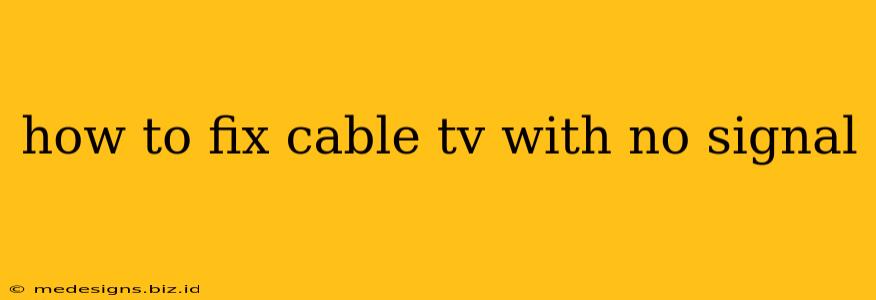Is your cable TV showing a frustrating "no signal" message? Don't panic! This comprehensive guide will walk you through troubleshooting steps to get your favorite shows back on the screen. We'll cover everything from simple checks to more advanced solutions, helping you pinpoint the problem and get your cable TV back up and running.
Simple Checks: The Quick Fixes
Before diving into complex solutions, let's start with the easiest fixes. These often resolve the issue without needing advanced technical knowledge.
1. Check All Connections:
- Cables: Carefully examine all cables connecting your cable box, TV, and wall outlet. Look for loose connections, damaged cables (frayed or bent), or incorrect cable inputs. Make sure the cables are securely plugged into both ends. Try different cables if you have spares.
- Power: Ensure your cable box and TV are properly plugged into working power outlets. Try different outlets to rule out power issues.
- Input Source: On your TV, confirm you've selected the correct input source (HDMI, coaxial, etc.) that corresponds to your cable box connection.
2. Restart Your Equipment:
Sometimes, a simple restart can resolve temporary glitches. Unplug both your cable box and TV from their power outlets. Wait for about 30 seconds, then plug them back in and power them on. This allows the equipment to refresh and clear any minor software errors.
3. Check for Outages:
Contact your cable provider to check for any reported outages in your area. Outages are often announced on their website or app. If there's an outage, there's not much you can do besides wait for the provider to restore service.
Intermediate Troubleshooting: Diving Deeper
If the simple checks didn't work, let's move on to more in-depth troubleshooting steps.
4. Inspect the Coaxial Cable:
- Signal Strength: Weak signals can cause "no signal" errors. Carefully inspect the coaxial cable running from the wall to your cable box. Look for any kinks, bends, or damage along its length. A damaged cable needs replacement.
- Connections at the Wall: Check the coaxial cable connection at the wall outlet. Make sure it is securely screwed in.
5. Check the Cable Box:
- Internal Issues: If your cable box is older or has been exposed to extreme temperatures, internal components might have failed. Contact your cable provider about repair or replacement options.
- Software Update: Some cable boxes can be updated via their on-screen menu. Check for any available software updates to ensure you have the latest version.
Advanced Troubleshooting: When Things Get Tricky
If you've exhausted the simpler solutions, it's time to consider more advanced troubleshooting or seeking professional help.
6. Signal Meter Test (If Possible):
Some cable boxes or advanced meters can measure the signal strength. A low signal strength indicates a problem with the cable line itself.
7. Contact Your Cable Provider:
If none of the above steps work, contacting your cable provider is crucial. They can diagnose more complex issues like problems with the main cable line or your account. They might send a technician to inspect your setup.
Preventing Future "No Signal" Issues
- Regular Cable Inspections: Periodically check your cables and connections to ensure everything is secure and in good condition.
- Protect Cables: Avoid placing heavy objects or furniture on your cables, which can cause damage over time.
- Keep Equipment Clean: Dust buildup can affect electronic components. Regularly clean your cable box and TV to prevent overheating and malfunctions.
By following these steps, you should be able to resolve most "no signal" issues with your cable TV. Remember, patience and methodical troubleshooting are key to identifying the problem and getting your entertainment back on track!
